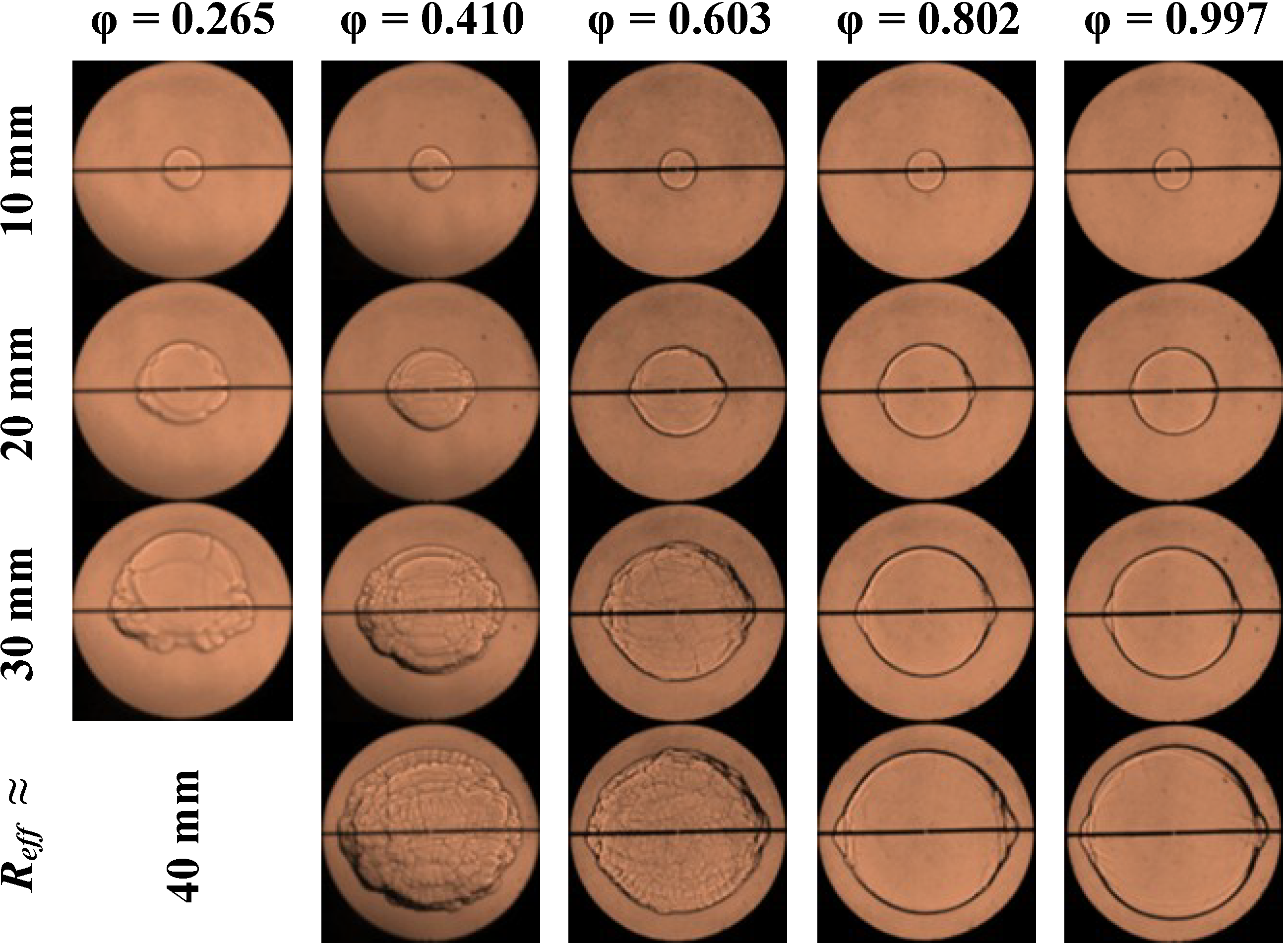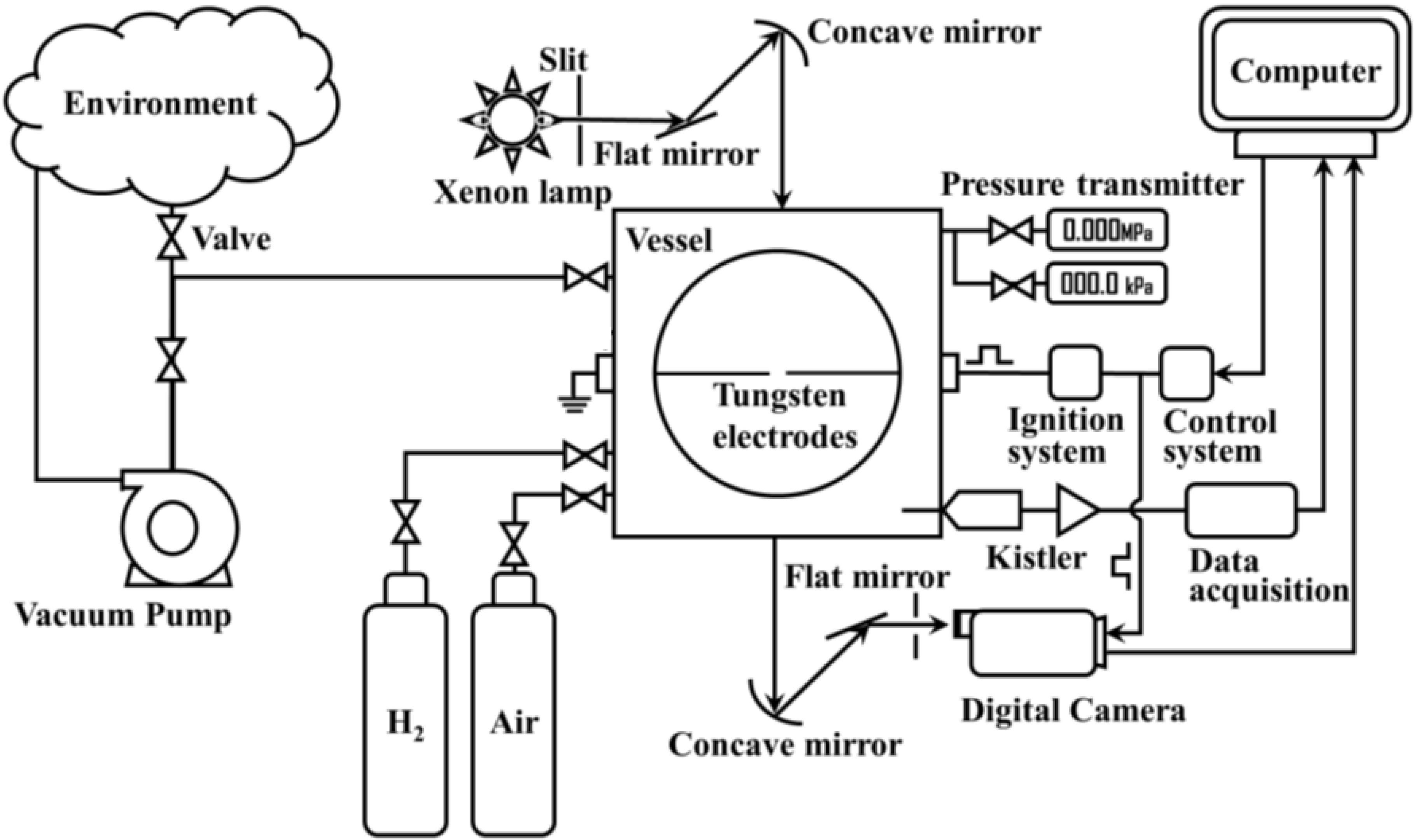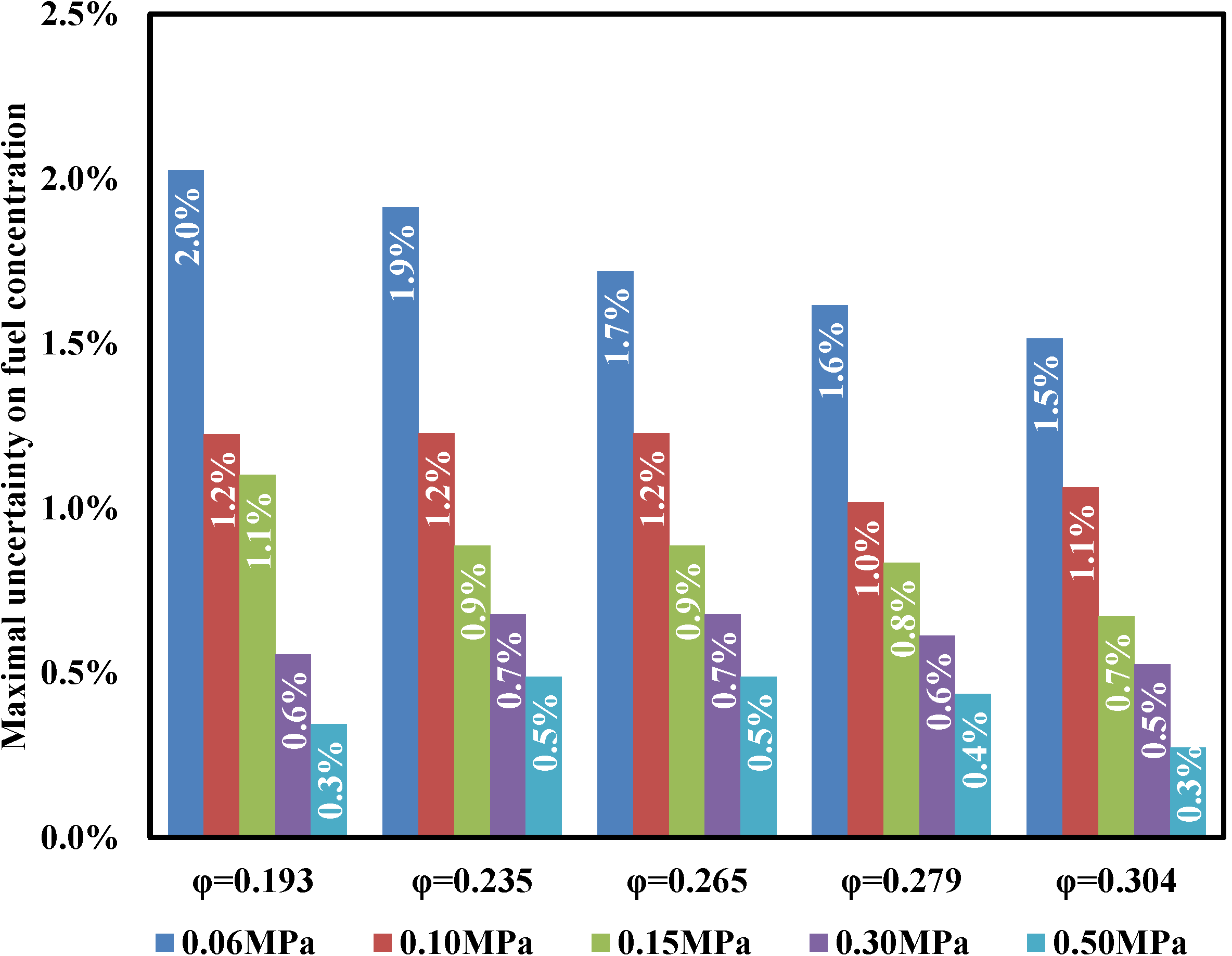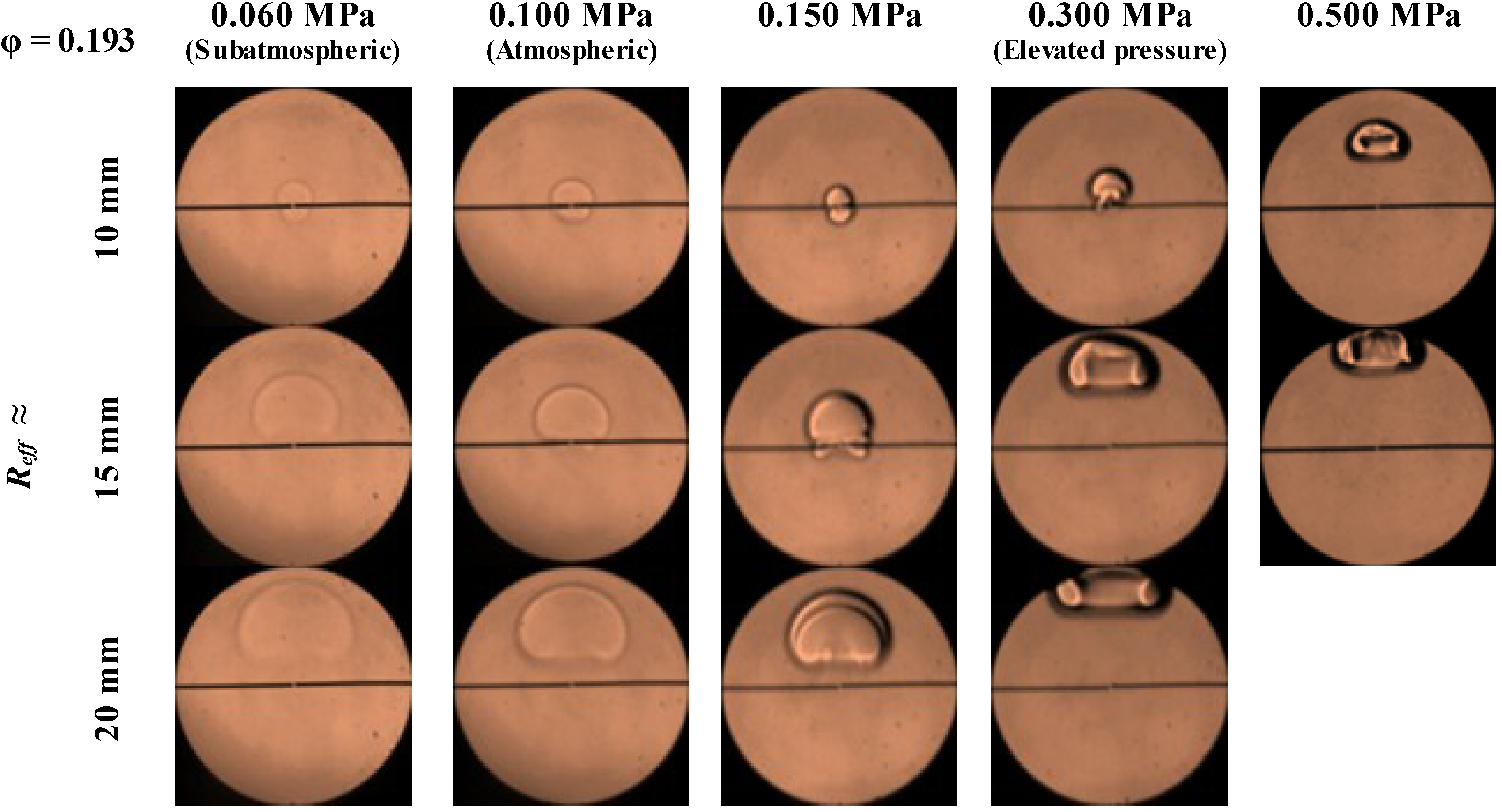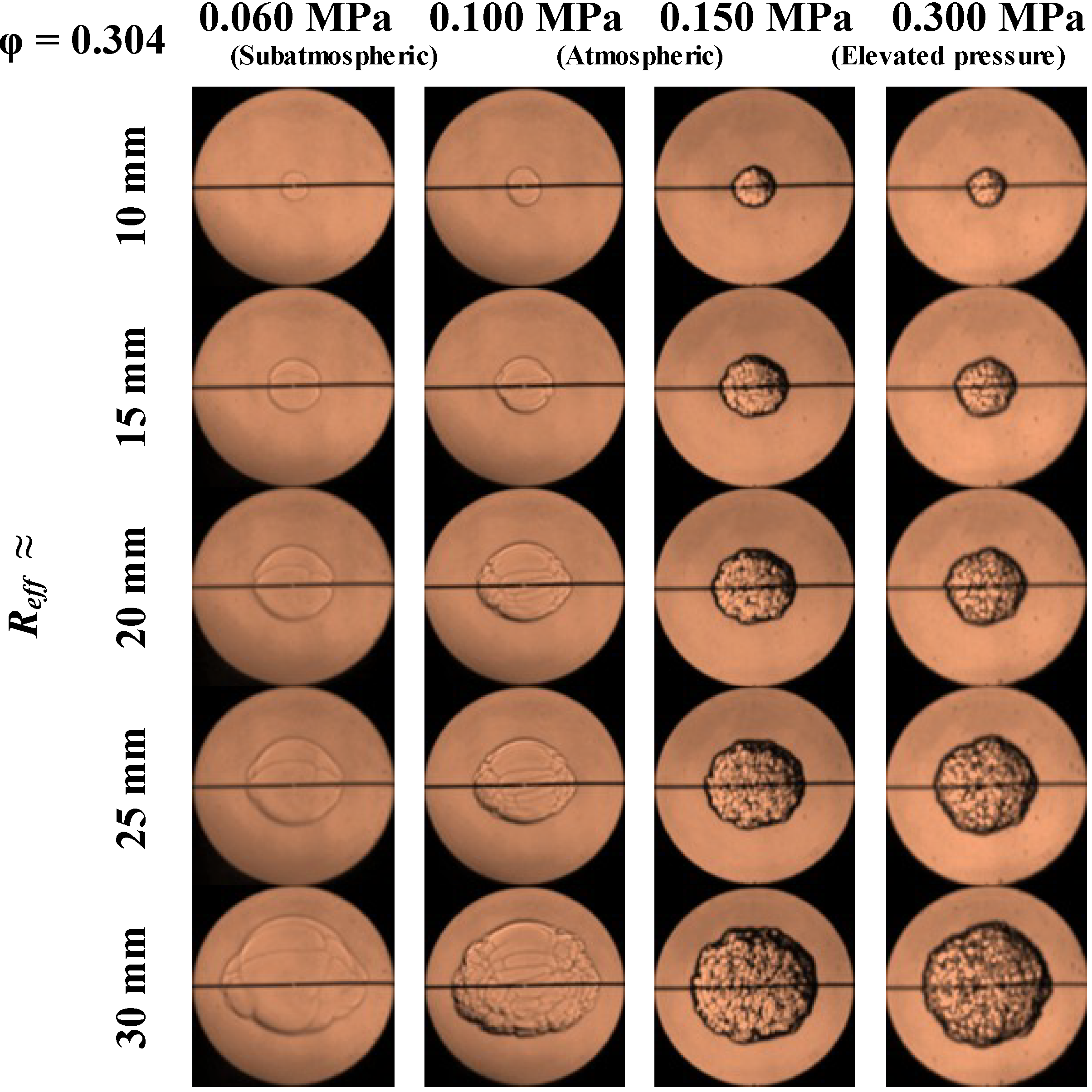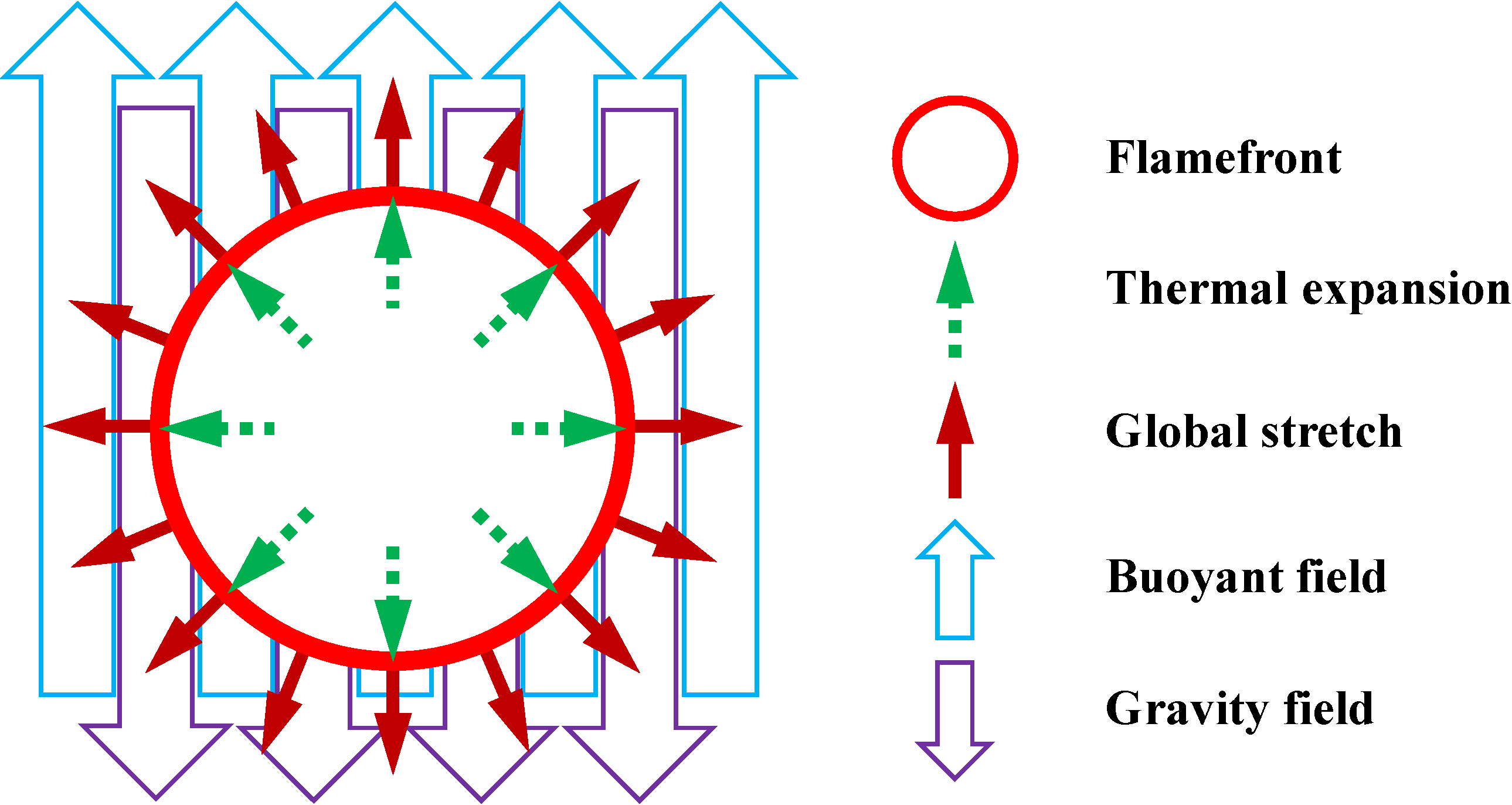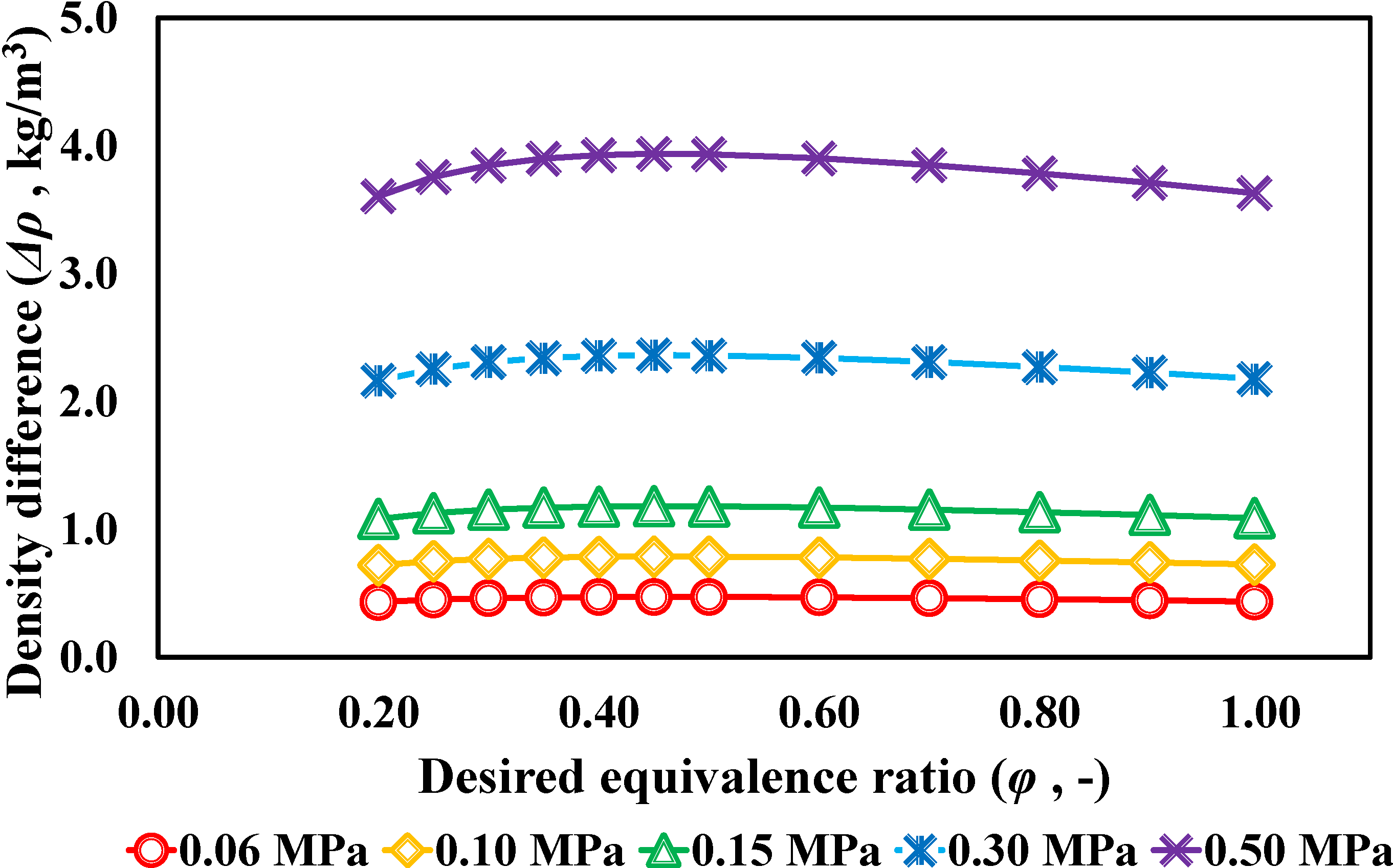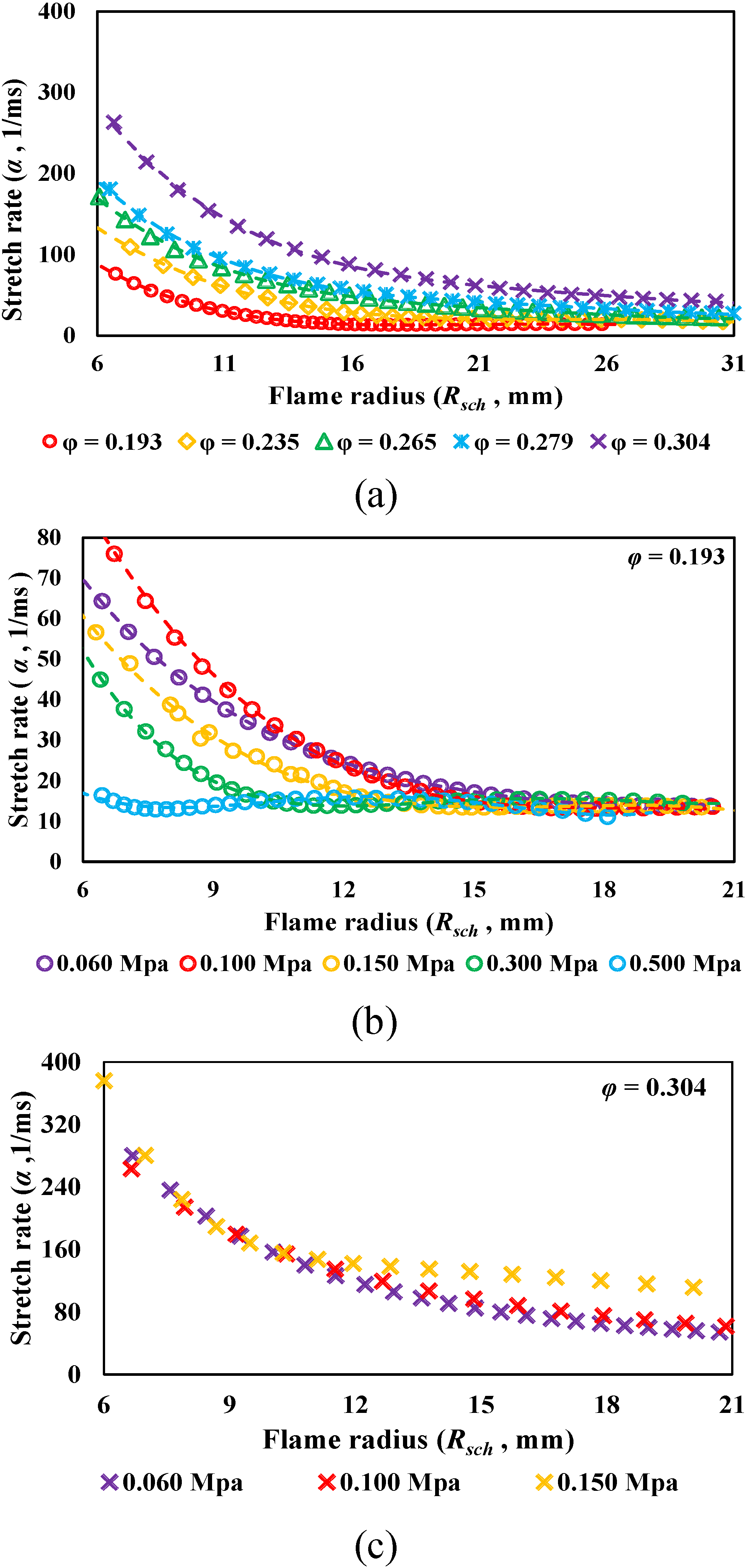3.1. Observation of the Morphology of Buoyant Unstable Behavior
Figure 4 shows the Schlieren images of hydrogen-air premixed flames with different φ (from 0.193 to 0.304) under atmospheric pressure and room temperature, in which,
Rsch is the flame radius of the Schlieren image of the flame front, and it is the calculation result from the flame front’s projection area (
A) given by:
As can be seen, during the initial period of propagation (within which
Rsch ≤ 10 mm), nearly all the investigated lean hydrogen premixed flames give a similar propagation behavior in that the flame front propagates outwardly from the ignition position in a spherical manner associated with a smooth surface. For the lean hydrogen premixed flames whose φ falls into the range of 0.265 to 0.304, as flame further propagates, some obvious cracks occur and develop on the flame front (as can be observed on those “relatively richer” lean hydrogen premixed flames shown in
Figure 1); but for the lean hydrogen premixed flames with φ = 0.193 and φ = 0.235, the flame front is always smooth during the subsequent propagation.
Figure 4.
Schlieren images of hydrogen-air premixed flames with different equivalent ratios at atmospheric pressure and room temperature.
Figure 4.
Schlieren images of hydrogen-air premixed flames with different equivalent ratios at atmospheric pressure and room temperature.
It can be summarized that, for the lean hydrogen premixed flames within the investigated range of fuel concentrations, the “cellularization” of the flamefront has been suppressed with the decrease of fuel concentration, which is distinct from the traditional understanding of the trends of the variation of the cellularization of lean hydrogen premixed flames which is dominated by thermal-diffusive instability.
Accompanying the suppression of cellularization on the flame front, the manner of flame propagation, flame shape, cells’ development and cells’ distribution are noticeably changed from what is observed in
Figure 4. Firstly, regarding the aspect of propagation’s manner, the flame has begun to show a tendency of upward propagation when it has propagated to a certain size, and the leaner the flame is, the more obvious the upward tendency becomes, and even lean hydrogen premixed flames with φ = 0.193 and φ = 0.235 have been totally lifted up during the propagation when
Rsch ≤ 20 mm. Secondly, on the aspect of flame shape, due to the remarkable upward propagation, the upper part of the flame front has been elongated, and the curvature of the upper part becomes more arc-like while that of the lower partial becomes more flat. Thirdly, on the aspect of cells’ development, for those lean hydrogen premixed flames for which cells can also be observed on the flame front, the cells on the lower part still uniformly split into new cells as the flame further propagates, but the cells on the upper part just expand rather than continuously splitting when the flame front has begun to propagate upwards. Fourthly, on the aspect of cells’ distribution, for those cellular hydrogen premixed flames, due to the different manner of cell development, the cells’ distribution in the upper part is distinct from the uniform distribution on the lower part, and the cells on the upper part are larger in size and less in the number. Since the mentioned four behaviors observed from
Figure 4 are distinct from what has always been reported for lean hydrogen premixed flames dominated by thermal-diffusive and hydrodynamic instability, we summarize them as distinct behaviors of buoyant instability, and it also can be concluded that such buoyant instability behaviors are enhanced with the decrease of fuel concentration for lean hydrogen premixed flames under normal pressure and room temperature.
Figure 5 shows the Schlieren images of hydrogen-air premixed flames with φ = 0.193 at room temperature under different
Pint conditions. From the comparisons shown in the figure, three phenomena can be easily observed. Firstly, the hydrogen premixed flame with φ = 0.193 will be totally lifted up during the propagation under all the investigated
Pint conditions, but the flame still propagates outwardly with a spherical shape within the initial period of propagation under reduced, normal, and certain elevated pressures (such as 0.150 MPa). Secondly, for a similar flame size, the lift height under reduced and normal pressure are lower than those of flames under elevated pressures; under elevated pressures, the higher the
Pint is, the higher the lift height becomes. Thirdly, the flame front is very smooth under reduced and normal pressures, but there exists some obvious “signets” on the flame front under elevated pressures, and the higher the
Pint is, the “deeper” the signet can be observed. Based upon the behaviors observed in
Figure 5, it seems that the buoyant instability behavior can be enhanced by increasing
Pint.
Figure 5.
Schlieren images of hydrogen-air premixed flames with φ = 0.193 at different pressures and room temperature.
Figure 5.
Schlieren images of hydrogen-air premixed flames with φ = 0.193 at different pressures and room temperature.
Figure 6 shows the Schlieren images of hydrogen-air premixed flames with φ = 0.304 at room temperature under different
Pint conditions. As can be seen, the investigated lean hydrogen premixed flames can maintain the initial spherical outward propagation under elevated pressures, and the upward propagation tendency can just be observed for relatively larger flame sizes under reduced and normal pressure, and the tendency is indeed unremarkable. Under the investigated elevated pressures, the cells formed on the flame front are distributed and develop uniformly, but under reduced and normal pressure, the gradient distribution in size of those cells on the upper part of flame front can still be observed. The higher the
Pint is, the more cellular the flame front with a similar flame size becomes, and the less remarkable the tendency of upward propagation becomes, that is, the weaker the buoyant instability behaviors become. Although the observed phenomena are distinct from what is observed in
Figure 5, but it is normal considering the traditional understanding of the behavior of lean hydrogen premixed flames. With the absence of buoyant instability for hydrogen premixed flames, increasing
Pint will enhance the intensity of the hydrodynamic instability while the thermal-diffusive instability remains unchanged, and the enhanced hydrodynamic instability could enhance the cellularization of flame front; therefore, it seems such phenomena can be easily explained. However, the hydrogen premixed flames with φ = 0.193 under a different
Pint also suffer the similar variation trends of hydrodynamic and thermal-diffusive instability, but why do they show distinct phenomena (as shown in
Figure 5)? Through the comparisons between the observations on the flame images, it can be found that the two different variation trends of unstable behaviors are accompanied by the distinct phenomenon that the hydrogen premixed flames with φ = 0.193 had been lifted up prior to the formation of cells while a “floating” of the hydrogen premixed flames with φ = 0.304 (if it happened during the propagation) occurs after the formation of cells. Therefore, when the lean hydrogen premixed flames begin to float the trend of such floating is essential to the variation regulations of the unstable behavior of lean hydrogen premixed flames. Therefore, one should make quantitative studies on such buoyant unstable behaviors by examining the “floating” trends of the investigated flames.
Figure 6.
Schlieren images of hydrogen-air premixed flames with φ = 0.304 at different pressures and room temperature.
Figure 6.
Schlieren images of hydrogen-air premixed flames with φ = 0.304 at different pressures and room temperature.
3.2. Studies on the Buoyant Instability Trends
Based upon the abovementioned and discussed phenomena, the extent of upward propagation is the most remarkable behavior of the buoyant instability and is also an essential aspect to determine how the unstable buoyant behaviors happen; therefore, it can be taken as the indicator for quantitatively describing the “intensity” of the buoyant instability. Within the present investigation, the extent of upward propagation is indicated by a parameter “Float Rate, Ψ” which is defined as:
where
Dtop is the distance from the ignition position to the flame’s top;
Dbottom is the distance from the ignition to the flame’s bottom; and Δ
L is the difference between
Dtop and
Dbottom. It can be clearly understood that, for a specific
Rsch, larger the Δ
L is, the more obvious the buoyant instability behavior becomes; while, for a specific Δ
L, the smaller the
Rsch is, the more obvious the buoyant instabilty; therefore, the parameter “float rate” provides a good comprehensive characterization of the buoyant instability.
Figure 7 shows the variation of Ψ with
Rsch under different conditions. As can be seen, under all the investigated conditions, the value of Ψ increases as
Rsch increases, namely, such buoyant instability will be continuously enhanced as flame expands once the buoyant instability has ocurred, which means the buoyant instability behaviors have a self-enhancing nature. From
Figure 7a, it can be found that, during the period of constant pressure, Ψ increases as the flame expands with an accelerating growth rate, and the rate of acceleration at a specific
Rsch is increased with the reduction of φ, which indicates that the leaner the hydrogen premixed flame is, the stronger the buoyant instability becomes. When the flame front enters a zone with an increasing pressure, Ψ still increases as the flame expands but the growth rate of Ψ the decreasing noticeably.
Figure 7.
Variation of Float Rate with flame radius: (a) with different equivalence ratios under atmospheric pressure; (b) with φ = 0.193 under different initial pressures; (c) with φ = 0.265 under different initial pressures; and (d) with φ = 0.304 under different initial pressures.
Figure 7.
Variation of Float Rate with flame radius: (a) with different equivalence ratios under atmospheric pressure; (b) with φ = 0.193 under different initial pressures; (c) with φ = 0.265 under different initial pressures; and (d) with φ = 0.304 under different initial pressures.
Compared to the influences of φ on the buoyant instability, the influences of
Pint on the variation trends of Ψ are relative complex. As can be seen from
Figure 7b, for the lean hydrogen premixed flame with φ = 0.193, as
Pint increases, Ψ at a similar
Rsch firstly decreases and then increases, and the minimal value is attained at atmospheric pressure; which indicates the variation of
Pint (relative to atmospheric pressure) could enhance the intensity of the buoyant instability. For the lean hydrogen premixed flames with φ = 0.265 and φ = 0.304, the values of Ψ at a specific
Rsch monotonously increases as
Pint increases. Furthermore, no matter whether promoting or restraining, the effects of
Pint on the variation of Ψ become weaker as φ increases.
As mentioned above and discussed in the previous subsections, when the lean hydrogen premixed flames have begun to be lifted up is essential to the variation trends of the buoyant instability behavior; therefore, we propose the term “critical flame radius,
Rcr” (which is defined as the flame radius at which Ψ has increased up to 10%) as the indicator to the onset of the buoyant instability. As shown in
Figure 8, for the lean hydrogen premixed flames with φ ≤ 0.235,
Rcr generally decreases as
Pint increases, and the extent of decrease is enlarged as
Pint increases for a specific φ, and the variation extent decreases as φ increases. For the flames with φ ≥ 0.265,
Rcr increases as
Pint increases, the extent of
Rcr varies noticeably with the increase of
Pint for a specific φ and/or the increase of φ for a specific
Pint. Furthermore, combined with the observed flame images, for the lean hydrogen premixed flames with φ = 0.193 and φ = 0.235,
Rcr is less than the flame radius at which cells can be observed on the flame front (actually, for most investigated cases in the present article, no cells have been formed on those flames while the flame was still propagating within the field of view); for the lean hydrogen premixed flames with φ = 0.265, φ = 0.279 and φ = 0.304,
Rcr is larger than the flame radius at which cells have been formed.
Figure 8.
Critical flame radius effect on the buoyant instability for hydrogen-air premixed flames with initial pressure for different equivalence ratios.
Figure 8.
Critical flame radius effect on the buoyant instability for hydrogen-air premixed flames with initial pressure for different equivalence ratios.
Based upon the observation and trends mentioned above, it can be supposed that decreasing φ could promote the buoyant instability under a specific Pint, but the effects of Pint on the buoyant instability are different for different φ values.
3.3. Discussion on the Dominating Role of the Buoyant Instability
An outwardly propagating flame mainly suffers three forces, besides its own thermal expansion, which are respectively the stretch force, buoyancy, and gravity, as shown in
Figure 9. For a spherical outwardly propagating flame, in the absence of the influence of electrodes, the stretch force upon the right semi-part should be equal to that upon the left semi-part due to the symmetrical structure, and thus the flame movement in the vertical direction is dominated by the combined effect of buoyancy and gravity. It should be noted that the differences in geometric parameters (including the length, radius, roughness,
etc.) and physical characteristics (such as materials, carbon laydown on the surface of electrodes) of electrodes can induce differences in the stretch forces on the right and left semi-parts, and these unbalanced stretch forces on both semi-parts can be observed from the flame shape if such differences are sufficiently large. Due to the good symmetrical characteristics observed in the flame images, such differences were neglected in the present article.
Figure 9.
Schematic diagram of the forces acting upon a spherical propagating flame.
Figure 9.
Schematic diagram of the forces acting upon a spherical propagating flame.
According to the Archimedes’ principle, the buoyancy of a flame is the product of gravity acceleration, the flame’s volume, and the unburned reactants’ density; therefore, the combined effect of buoyancy and gravity can be indicated by the flame’s volume and the density difference across the flame front (Δρ, the difference on the density between the unburned and the burned fuel). If we consider combustion occurs at an adiabatic temperature and composition at constant pressure, the value of Δρ is a constant value during the flame’s propagation, and hence the global result of the competition between buoyancy and gravity is being increased during the propagation due to the flame’s increasing volume, which explains well why Ψ increases as Rsch increases under any conditions.
Figure 10.
Density difference of hydrogen-air premixed flames with equivalence ratio under different initial pressures.
Figure 10.
Density difference of hydrogen-air premixed flames with equivalence ratio under different initial pressures.
Figure 10 shows the variation trend of Δρ with φ under different
Pint, where both the densities of unburned and burned mixtures are calculated using the chemical equilibrium program GASEQ [
29]. As can be seen, for lean hydrogen premixed flames, with the increase of φ, the value of Δρ firstly increases and then decreases, and the maximal value is attained near φ = 0.4, but the difference in Δρ can hardly be observed when
Pint is no more than 0.15 MPa. The calculated results indicate that, for the case of
Pint ≤ 0.15 MPa, the global result of the competition between buoyancy and gravity is similar for different φ values, that is, the effects of such competition hardly induce any obvious difference as the fuel concentration varies; while, for the case of 0.30 MPa ≤
Pint ≤ 0.50 MPa, the competition between buoyancy and gravity will be weakened when the fuel concentration becomes much leaner than 0.4. Furthermore, for a specific φ, the higher the
Pint is, and the larger the value of Δρ becomes, which means the global result of the competition between buoyancy and gravity should be enhanced.
However, just some cases (in which φ ≤ 0.235) in our investigation can be explained well by the variation trend, and the others (in which 0.265 ≤ φ) still cannot be explained by solely considering the influence of Δρ. Therefore, other factor(s) must exist that affect the buoyant instability.
Actually, as a result of the competition between buoyancy and gravity, the global stretch forces on both semi-parts of the flame in the gravity direction can hardly be absolutely balanced; as observed from
Figure 1,
Figure 4, and
Figure 5, the flame curvature of the upper part of the flame front is distinct from that of the lower part. For provide further information about the unstable premixed flames, the global stretch forces acting upon the flames have been analyzed quantitatively using the “stretch rate” (α), which reflects the intensity of the stretch effects by the variation trend of the flame fronts’ area, is defined as the Lagrangian time derivative of the logarithm of the area of flame, as given in [
30]:
where
A is the area of the projected flame’s image.
Figure 11 shows the variation of global stretch rate with flame radius under different fuel concentrations and initial pressures. As can be seen from
Figure 11a, under normal pressure and room temperature, as
Rsch increases, α decreases towards a convergent value rather than zero as the interference between the flame and the unburned reactants won’t vanish, the value of α at a same
Rsch decreases as φ decreases. The results indicate that the global stretch force acting upon the flame declines towards a certain level as the flame expands for a specific lean hydrogen premixed flame, and the global stretch force is weakened with the decrease of fuel concentration under normal pressure. Actually, during the initial period of propagation, the flame’s volume is very small, and the result of the competition between buoyancy and gravity is correspondingly small, but the stretch force on the flame is the largest for the whole propagation; however, as the flame propagates further, the result of the competition between buoyancy and gravity is being enlarged due to the flame’s increasing volume, while the stretch force on the flame is declining remarkably. Without consideration of any other external forces, a strong result of the competition between buoyancy and gravity will drive the flame upwards, and the stronger such competition is, the more obvious the upward propagation will become; with the absence of buoyancy effects, a strong stretch can kept the flame front smooth and propagating outwardly with the suppression of the unstable behaviors [
31,
32,
33]. Based upon the observed unstable behaviors and the mentioned analysis, it can be said that the initial spherical propagation of lean hydrogen premixed flames is dominated by the strong global stretch force rather than the weak competition between buoyancy and gravity, and the later upward propagation of the lean hydrogen premixed flame is caused by the sufficiently strong competition between buoyancy and gravity.
Figure 11.
Global stretch rate of hydrogen-air premixed flames with flame radius: (a) with different equivalence ratios under atmospheric pressure; (b) with φ = 0.193 under different initial pressures; and (c) with φ = 0.304 under different initial pressures.
Figure 11.
Global stretch rate of hydrogen-air premixed flames with flame radius: (a) with different equivalence ratios under atmospheric pressure; (b) with φ = 0.193 under different initial pressures; and (c) with φ = 0.304 under different initial pressures.
From
Figure 11b, it can be found that, for the hydrogen-air premixed flames with φ = 0.193, the values of α at a same
Rsch are distinct under different
Pint during the initial period of propagation, but such differences decline noticeably as flame propagates further, and the difference can even be neglected when
Rsch is more than 15 mm. For the initial period of propagation, as
Pint increases within the investigated range, α at a same
Rsch firstly increases and then decreases, and the maximal value is attained at atmospheric pressure. The results indicate that for such lean hydrogen premixed flames under normal and elevated pressures, the higher the
Pint is, the weaker the intensity of the global stretch force becomes; furthermore, the competition between buoyancy and gravity is enhanced (as reported in
Figure 10). Therefore, the intensity of the competition between buoyancy and gravity may exceed the intensity of the global stretch force, and such a difference will be enhanced with the increase of
Pint. Under reduced pressure, both the intensities of the global stretch force and the competition between buoyancy and gravity are weakened compared to the normal pressure, but the difference between the two aspects may also weaken, which means the composite effects of such a difference may be stronger than those under normal pressures; hence, the buoyant instability behavior would be enhanced compared to that seen under normal pressure. Such conclusions can better explain the buoyant instability behaviors observed in the present article for the lean hydrogen premixed flames with φ = 0.193 and φ = 0.235 (which have similar variation trends for both Δρ and α).
From
Figure 11c, it can be found that for the premixed hydrogen-air flames with φ = 0.304, the value of α at a same
Rsch increases monotonously as
Pint increases within the investigated range, the difference on α is relatively smaller during the initial propagation period, but such a difference increases remarkably as the flame propagates further. For the initial period of propagation, the difference of α is not obvious under different
Pint values, which means verifying the initial pressure won’t induce any noticeable variation of the global stretch force acting on the flame front; however, the competition between buoyancy and gravity will be enhanced by increasing
Pint, namely, the buoyant instability potential has been enhanced. However, from the flame images shown in
Figure 6, few related phenomena can be observed. Actually, by making a comparison between the cases ofφ = 0.193 and φ = 0.304, it can be found that the influence of
Pint on the value of Δρ is highly similar (shown in
Figure 10), namely, the competition between buoyancy and gravity under a specific
Pint is mostly kept at a similar level; however, the values of α at a same
Rsch are distinct, the minimal value of α for the case of φ = 0.304 is even higher than the maximal value of the case of φ = 0.193 for a specific
Pint, that is, the intensity of the global stretch force on the flame front has been significantly enhanced. Therefore, it can be said that for lean hydrogen premixed flames with φ = 0.304, increasing
Pint induces an obvious enhancement of the global stretch force rather than the competition between buoyancy and gravity, and the role of global stretch force on maintaining the flame spherically outwardly dominates the effect of the competition between buoyancy and gravity driving the flame upwards, and hence the flame will not display any obvious buoyant instability behaviors. However, when the flame has propagated to a certain size, the increased competition between buoyancy and gravity (induced by the flame’s increasing volume) will exceed the declining global stretch force, and then the tendency of upward propagation will appear again (as shown in
Figure 6).
Figure 12 shows the variation trend of flow rate with global stretch rate under different conditions. As can be seen, the flow rate will not be observed when the stretch rate is still sufficiently large, and the value will be remarkably increased when the stretch rate further decreases from certain smaller values. Comparing the cases of lean hydrogen premixed flames with φ = 0.193 and with φ = 0.304, it can be seen that under a specific
Pint, the value of Ψ for the leaner flame is lower than that for the richer, which is similar to the correlation of Δρ. The results again indicate that the buoyant instability is related to Δρ (the competition between buoyancy and gravity) and α (the global stretch force).
Figure 12.
Flow rate of hydrogen-air premixed flames with global stretch rate: (a) with different equivalence ratios under atmospheric pressure; (b) with φ = 0.193 and φ = 0.304 under different initial pressures.
Figure 12.
Flow rate of hydrogen-air premixed flames with global stretch rate: (a) with different equivalence ratios under atmospheric pressure; (b) with φ = 0.193 and φ = 0.304 under different initial pressures.
Based upon the above discussions, it can be concluded that whether the buoyant instability can be seen or not is determined by the result of the competition between the stretch force acting on the flame and the combined resultant of buoyancy and gravity, and the flame won’t show an obvious buoyant instability if the stretch force plays a dominant role in the propagation; otherwise, the flame will propagate upwards.
